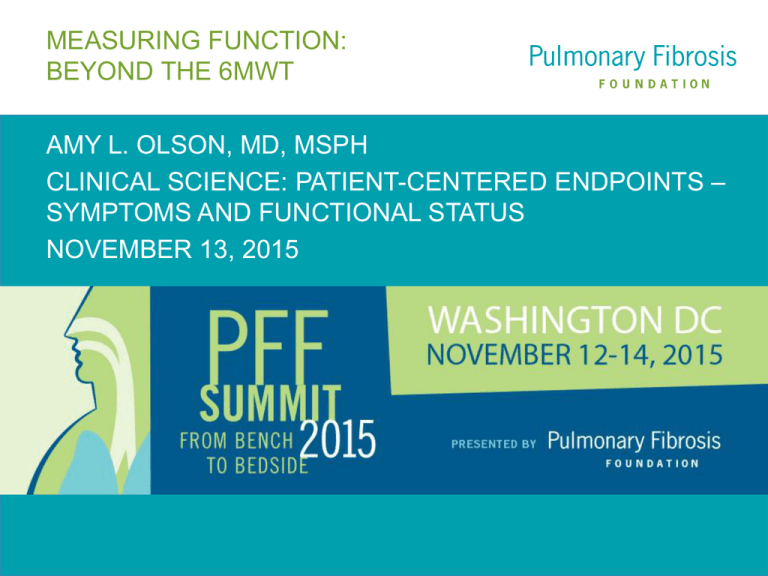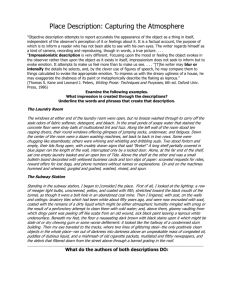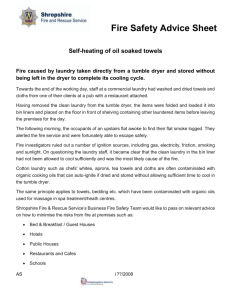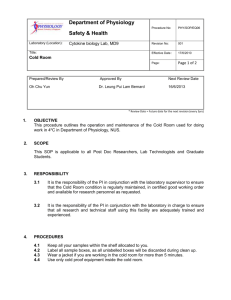
MEASURING FUNCTION:
BEYOND THE 6MWT
AMY L. OLSON, MD, MSPH
CLINICAL SCIENCE: PATIENT-CENTERED ENDPOINTS –
SYMPTOMS AND FUNCTIONAL STATUS
NOVEMBER 13, 2015
OBJECTIVES …
What clinical endpoints are relevant to the patient?
How do we define functional status?
How have we measured functional status?
CS-PFP (Continuous Scale Physical Function Performance
Test)
• Test-retest Reliability in IPF
• Internal Consistency in IPF
• Future Directions
• If we can better assess this clinical end-point, can we
intervene to improve function status?
•
•
•
•
©2015 Pulmonary Fibrosis Foundation. All rights reserved.
2
CLINICAL ENDPOINTS
In trials, what clinical end-points are relevant to the
patient?
– Characteristics or variables that reflect how a patient:
• Survives (Robust, but costly)
• Feels (IPF-specific PROs: ATAQ-IPF and SGRQi)
• Functions (6MWT, CPET, new tools?)
– These end-points are unquestionably relevant to the
patient
– In trials, results that use these clinical end-points are
more easily and confidently interpreted
Biomarkers Definitions Working Group. Clin Pharmacol Ther 2001;69:89-95.
Olson AL, Swigris JJ, Brown KB. QJM 2012;105:1043-1047.
©2015 Pulmonary Fibrosis Foundation. All rights reserved.
3
HOW IS FUNCTIONAL STATUS
DEFINED?
“The ability to perform basic activities
and participate in life situations.”
National Committee on Vital and Health Statistics: classifying and reporting
functional status. 1998. Available from www.ncvhs.hhs.gov/010617rp.pdf.
©2015 Pulmonary Fibrosis Foundation. All rights reserved.
4
HOW HAVE WE MEASURED
FUNCTIONAL STATUS?
• Six-minute walk test
– Submaximal exercise test
– Unstandardized administration
• “As far as possible” vs. “As fast as possible”
– Some have reported poor reproducibility*
– What to do with supplemental oxygen?
• Altitude (i.e., study design)
– Does it really tell us anything about functional status
– the ability to do basic activities and participate in
life situations?
Wier NA et al. Chest 2013;144:1900-1905.
Du Bois RM, et al. Am J Respir Crit Care Med 2011;189:1231-1237.
Azuma A et al. Am J Respir Crit Care Med 2005;171:1040-1047.
Elpern EH et al. Chest 2000;118:98-105.
Eaton T, et al. Am J Respir Crit Care Med 2005;171:1150-1157.
©2015 Pulmonary Fibrosis Foundation. All rights reserved.
5
HOW HAVE WE MEASURED
FUNCTIONAL STATUS?
• Cardiopulmonary
Exercise Testing
– IPF patients with a
VO2 max of less than
8.3 ml/kg/min at
baseline had an
increased risk of
death.
– How do abnormal
VO2 tests translate
into functional
status?
Fell D, et al. Am J Respir Crit Care Med 2009;179:402-407.
©2015 Pulmonary Fibrosis Foundation. All rights reserved.
6
FUNCTIONAL STATUS –
NO GOLD STANDARD ON HOW TO
MEASURE FS
Physiological Capacity
(eg, leg strength)
Physical Performance
(eg, stair climbing)
FS
Psychosocial Factors
Cress ME et al. Arch Phys Med Rehabil 1996;77:1243-1250.
FUNCTIONAL STATUS –
NO GOLD STANDARD
Physiological Capacity
(eg, leg strength)
Physical Performance
(eg, stair climbing)
FS
Psychosocial Factors
Cress ME et al. Arch Phys Med Rehabil 1996;77:1243-1250.
CONTINUOUS-SCALE
PHYSICAL FUNCTION
PERFORMANCE TEST
(CS-PFP)
• CS-PFP
– Functional status assessment, developed per PT
– Based on the activities of daily living
– Test is conducted at maximum effort, within bounds
of safety and comfort
– Been developed devoid of ceiling and floor effects
– Been developed with defined physical domains, and
whole body functional status
– Been applied to normal aging populations,
Parkinson’s Disease, CVA survivors, CHF, COPD*
Cress ME et al. Arch Phys Med Rehabil 1996;77:1243-1250.
9
CS-PFP –
TEST CHARACTERISTICS
(OTHER POPULATIONS)
• Test-retest Correlations
– 0.84 to 0.97
• High Internal Consistency among Domains
– Cronbach’s alpha 0.74 to 0.97
• Sensitive to Detect Longitudinal Change in FS in
health/aging populations and other disease
states
– Questionnaires and 6 MWT were not sensitive
Cress ME et al. Arch Phys Med Rehabil 1996;77:1243-1250.
10
Physical Functional Performance
Tasks / Real Activities
(Short Form -10)
Upper
Body Strength
Upper Body
Flexibility
Lower
Body
Strength
Balance &
Coordination
Endurance
Low Difficulty
Carry a weighted pot a distance of 1
meter
(Pan Carry)
weight
time
Donning and removing a jacket
(Jacket)
time
Place and remove a sponge from an
adjustable shelf
(Shelf Reach)
distance
time
Moderate Difficulty
Floor Sweeping with broom and
dustpan
(Floor sweep)
time
time
time
time
time
time
Sit and stand up from the floor
(Floor down/up)
time
time
Climb stairs
time/step
time/step
weight
time
Transfer clothes from washer to
dryer & transfer clothes from dryer
to basket
(Laundry 1 and Laundry 2)
time
Pickup 4 scarves from the floor
(Scarf)
High Difficulty
Carry groceries
weight
Six minute walk test
distance
Total PFP time
time
Physical Functional Performance
Tasks / Real Activities
(Short Form -10)
Upper
Body Strength
Upper Body
Flexibility
Lower
Body
Strength
Balance &
Coordination
Endurance
Low Difficulty
Carry a weighted pot a distance of 1
meter
(Pan Carry)
weight
time
Donning and removing a jacket
(Jacket)
time
Place and remove a sponge from an
adjustable shelf
(Shelf Reach)
distance
time
Moderate Difficulty
Floor Sweeping with broom and
dustpan
(Floor sweep)
time
time
time
time
time
time
Sit and stand up from the floor
(Floor down/up)
time
time
Climb stairs
time/step
time/step
weight
time
Transfer clothes from washer to
dryer & transfer clothes from dryer
to basket
(Laundry 1 and Laundry 2)
time
Pickup 4 scarves from the floor
(Scarf)
High Difficulty
Carry groceries
weight
Six minute walk test
distance
Total PFP time
time
Physical Functional Performance
Tasks / Real Activities
(Short Form -10)
Upper
Body Strength
Upper Body
Flexibility
Lower
Body
Strength
Balance &
Coordination
Endurance
Low Difficulty
Carry a weighted pot a distance of 1
meter
(Pan Carry)
weight
time
Donning and removing a jacket
(Jacket)
time
Place and remove a sponge from an
adjustable shelf
(Shelf Reach)
distance
time
Moderate Difficulty
Floor Sweeping with broom and
dustpan
(Floor sweep)
time
time
time
time
time
time
Sit and stand up from the floor
(Floor down/up)
time
time
Climb stairs
time/step
time/step
weight
time
Transfer clothes from washer to
dryer & transfer clothes from dryer
to basket
(Laundry 1 and Laundry 2)
time
Pickup 4 scarves from the floor
(Scarf)
High Difficulty
Carry groceries
weight
Six minute walk test
distance
Total PFP time
time
Physical Functional Performance
Tasks
(Short Form -10)
Upper
Body Strength
Upper Body
Flexibility
Lower
Body
Strength
Balance &
Coordination
Endurance
Low Difficulty
Carry a weighted pot a distance of 1
meter
(Pan Carry)
weight
time
Donning and removing a jacket
(Jacket)
time
Place and remove a sponge from an
adjustable shelf
(Shelf Reach)
distance
time
Moderate Difficulty
Floor Sweeping with broom and
dustpan
(Floor sweep)
time
time
time
time
time
time
Sit and stand up from the floor
(Floor down/up)
time
time
Climb stairs
time/step
time/step
weight
time
Transfer clothes from washer to
dryer & transfer clothes from dryer
to basket
(Laundry 1 and Laundry 2)
time
Pickup 4 scarves from the floor
(Scarf)
High Difficulty
Carry groceries
weight
Six minute walk test
distance
Total PFP time
time
STUDY DESIGN
• IPF patients
– N = 16
– Extracted data from the EMR for baseline
characteristics
– Completed QOL questionnaires
– Test and retest within one week
– “Indoor tasks” = O2 concentrator (up to 15L)
– “Outdoor tasks” = Portable O2 system
Olson AL, et al. Expert Rev Respir Med 2015;9(3):361-7.
15
PERSONAL OBSERVATIONS
FROM THE TEST
• Extremely eye-opening to see how a patient (that
you see in clinic and think is doing well)
struggles with these “daily” tasks
• Patients, typically, did not have enough portable
oxygen for “outdoor tasks.”
– Oxygen saturations, if the patient checked, could be
extremely low
16
PATIENT
CHARACTERISTICS
N = 16
Mean (±SD)
Demographics
Age, years
Sex, male
(%)
BMI
Physiologic Variables
FVC, percent predicted
DLCO, percent predicted
6MWT distance, meters
Use of supplemental oxygen with activity
(%)
69.3 (±9.2)
56.3%
28.9 (±3.8)
65.0% (±20.4%)
39.9% (±21.1%)*
415.2 (±121.6)*
68.8%
17
TEST-RETEST
CHARACTERISTICS
Intraclass Correlation Coefficient was 0.84, p = 0.003
18
TEST-RETEST
CHARACTERISTICS
At a score of < 57,
in other populations
puts one is at risk of
losing independence
of daily living.
Intraclass Correlation Coefficient was 0.84, p = 0.003
TEST-RETEST
CHARACTERISTICS
81%
At a score of < 57,
in other populations
puts one is at risk of
losing independence
of daily living.
Intraclass Correlation Coefficient was 0.84, p = 0.003
TEST-RETEST
CHARACTERISTICS
21
TEST-RETEST
CHARACTERISTICS –
BLAND ALTMAN PLOT
In general, patients did slightly better on the second test, but there was no
relationship between FS and degree of improvement of the test. (p = 0.3)
22
INTERNAL CONSISTENCY
• Cronbach’s α = 0.91
– Excellent internal consistency
– Well above acceptable level of 0.7
23
CS-PFP VS.
HEALTHY AGE-MATCHED
COHORT
‡
*
*
‡
*
*
* p < 0.0001; ‡ UBS p=0.07; ‡ BALC p = 0.05
24
CORRELATION OF CS-PFP
WITH PHYSIOLOGY
Physiologic Variables
Physiologic Variables
FVC, percent predicted
DLCO, percent predicted
6MWT distance
Spearman Correlation
Coefficients
p-value
0.630
0.676
0.660
p = 0.009
p = 0.006
p = 0.008
25
CORRELATION OF CS-PFP
WITH QOL TOOLS
Quality of Life Variables
Spearman Correlation
Coefficients
p-value
0.649
0.002
p = 0.007
p = 0.996
General Health Perceptions Scale
0.234
p = 0.383
Emotional Well-being Scale
Emotional Health Problems Scale
0.251
0.313
p = 0.349
p = 0.238
Social Functioning Scale
Energy/Fatigue Scale
0.316
0.374
p = 0.234
p = 0.154
Total Score
-0.553
p = 0.097
Symptoms
Activity
Impact
Total
-0.182
-0.805
-0.582
-0.582
p = 0.499
p = 0.0002
p = 0.018
p = 0.018
SF-36 Domains
Physical Functioning Scale
Physical Health Problems Scale
UCSD
SGRQ Domains
These support the construct validity of the CS-PFP as a measure of FS.
26
CONCLUSIONS
• The CS-PFP:
– Has excellent test-retest characteristics in IPF
– Has excellent internal consistency
– Correlates with clinical and QOL variables, but the CS-PFP score
was not explained by these variables alone
• Supports construct validity of the test
– In our population, 81% had a score of < 57, and were at risk of
loosing independence.
– Assessment of CS-PFP domains found specific deficits in total
scores, and lower body strength and endurance
– Trends towards deficits in upper body strength and
balance/coordination
– No difference in Rate of Perceived Exertion (RPE)
27
LIMITATIONS
• Limitations:
– Small number
– Quaternary referral center
28
FUTURE DIRECTIONS
• Set-up onsite laboratory
• Repeat in larger population
• Targeted interventions
– LE weakness & Endurance?
– Home interventions?
– Adequate oxygenation?
– Therapeutics?
• Explore other factors (psychosocial) that limit FS
• Are there putative systemic effects (in muscles) from this
“lung limited process?”
29
ACKNOWLEDGEMENTS
NJ Health, Microgrant
Program
NJ Health, ILD Program &
Patients
NJ Health, Department of
Radiology
University of Colorado,
Physical Therapy Department
Kevin K. Brown
Jeffrey J. Swigris
Margaret Schenkman
Josh Solomon
Evans R. Fernandez- Perez
Tristan Huie
Stephen K. Frankel
Gregory Cosgrove
Amanda Belkin
Linda Hannen
Kunihiro Yagihashi
30
Questions?
Thank you.






